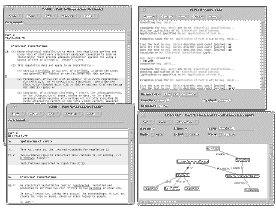
The diagram shows a snapshot of the screen during an actual PLINTH session, where the reader is consulting Part N of the Scottish Building Standards. There are two TOME text windows on the left, and the query tool and a network view are on the right.
Each part of the Standards has been marked up as a separate hypertext network using TOME. The Part N network consists of 14 nodes and 30 links in total, but for logical consultation only those nodes and links currently displayed in the network view are relevant.
To begin the consultation the reader clicks on a node in the network view, in
this case Reg.26(1) which is the logical starting point for Part
N (you can see the text of this node as the first clause in the upper TOME
window). The reader then clicks the Consult button on the query tool to
set the rules in motion.
The navigator follows the logical links and, or,
not and application down through the net of
requirement and scope nodes until it reaches the
nodes corresponding to the three clauses of Reg.26(2) which
contain exemption conditions for the standards in Part N. It then asks the
reader whether any of these clauses is satisfied, highlighting each one in its
TOME window in turn. In this example none is, so the answer is no in
each case. The navigator then works back up through the net, inferring from
the logical structure that the standards apply as no exemption condition has
been found. The reader is informed of this and the requirements node
N2:Electrical Installations is displayed (see the lower TOME
window in the diagram) and highlighted. There is no need for any further
breakdown into rules as the text is quite clear in itself.
Now suppose that, instead of answering no to each of the three clauses,
the reader answers yes to the second (Reg.26(2)b), as is
shown in the second consultation in the query tool window. At this point the
navigator knows that one exemption condition is satisfied, and it will not go
on to ask about the rest, but simply stop with the message:
Requirements in N2:Electrical Installations exempted by Reg.26(2)b